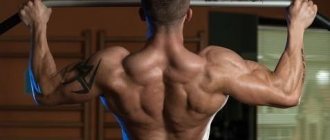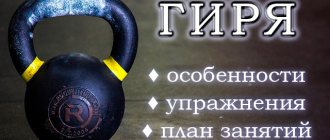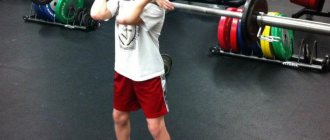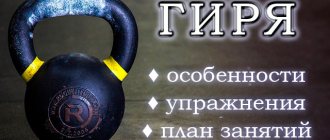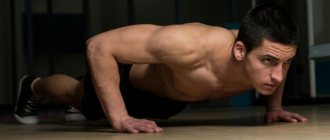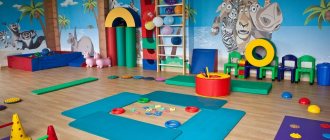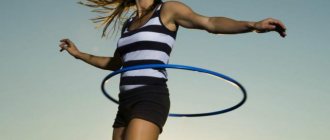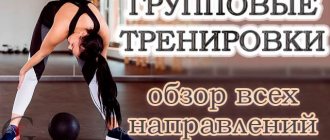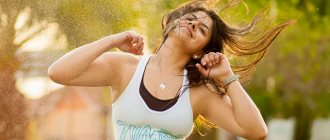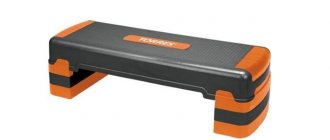Modern parents are concerned about the health and comprehensive development of their baby.
It is no secret that correctly selected physical activity from an early age has a positive effect on the formation of not only the child’s musculoskeletal system, but is also an integral part of the formation of his character.
Having decided that their child should play sports, parents are faced with a difficult choice: what type of training to prefer?
Recently, children's fitness has become increasingly popular - this is a relatively new sports area designed specifically for children.
Read more about the benefits of such classes and what are the specifics of training programs within this innovative industry.
Why should children do fitness?
The word “fitness” is now very popular and is often used to describe ordinary physical education or sports training. But if the initial goal of physical education and sports is to prepare for competitions and achieve victory, then fitness is done for well-being and maintaining health. In fact, this is a balanced complex in which you can include sports acrobatics and gymnastics, aerobics, yoga, stretching, choreography, and other elements, creating a health “cocktail” from them.
These classes are very exciting for children aged 3-7 years, as they are conducted in a playful way. The group can include children of different ages: from 3 years and older, of different levels of physical fitness. Only the trainer knows the lesson program; for the rest of the participants it is a fun, exciting game.
Thanks to children's fitness, a child will be able to:
- strengthen the immune system;
- improve the functioning of the lungs, cardiovascular system and vestibular system;
- avoid the formation of flat feet and postural disorders;
- increase flexibility;
- gain skills to control your body, develop coordination of movements.
If you have a problem with excess weight, playing gymnastics and rhythmic exercises will eliminate it. For hyperactive children aged 3-6 years, fitness will allow them to get rid of excess energy with health benefits. These activities also help develop a lot of useful social skills, which children can then use to communicate with peers in kindergarten or school. Among them:
- familiarization with the concept of discipline;
- communication skills in a multi-age group;
- establishing contact with peers;
- formation of a sense of rhythm;
- ability to resolve emerging conflicts, control emotions;
- improved attention;
- development of willpower.
Fitness classes can help correct character traits such as shyness and timidity. A 3-year-old child, shy of other children on the playground, as a rule, quickly joins the group, begins to feel like a part of it and makes his first friends.
Physical development in preschool
Children's fitness is a system of activities aimed at strengthening and maintaining the health of children.
The use of fitness movements in kindergarten not only fuels interest in sports activities and teaches them to enjoy physical activity, but also improves health. Children learn to understand and control their bodies. They develop muscle strength and body plasticity, acquire correct posture and a harmonious physique.
Sports activities in kindergarten not only develop children physically, but also have a beneficial effect on their psychomotor state. Kindergarten children develop harmoniously physically, spiritually and aesthetically.
Fitness goals in kindergarten
Physical activity contributes to the development of many qualities of a child. This includes the development of motor skills, high performance, and successful mastery of new material.
Outdoor games and physical exercise have a beneficial effect on processes such as memory, attention, imagination and thinking. Sport not only develops, but also disciplines and gives self-confidence.
At the same time, physical education can help children of different temperaments:
- passive guys will be able to open up to new energies, increasing their vitality;
- hyperactive kindergarteners will learn to harmoniously distribute their energy costs;
- capricious children will be able to feel the strength of their body and become more resilient.
It is all these problems that fitness for children is designed to solve.
If we take a separate kindergarten, then the main tasks of fitness in a preschool institution are:
- Formation and improvement of children’s physical qualities (endurance, coordination, strength, agility, speed)
- Prevention of disorders in the musculoskeletal system
- Introduction to healthy lifestyle and sports
These tasks are specified based on the age group of the children.
Fitness club program for different age groups
Children's fitness involves achieving different tasks in different kindergarten groups. The main ones are listed in the table.
| For whom | Tasks |
| For the younger group |
|
| For the middle group |
|
| For older kindergarteners |
|
Important! It is recommended to devote 2-3 times a week to sports activities in kindergarten, one of which would be outside.
How to organize children's outdoor sports activities is shown in the video:
.
Children's fitness areas
Every year new branches appear in children's fitness. This is natural, since the system is built in a gaming format for children, which is based on dynamics and development. For children under 3 years of age, classes are not divided by type; for slightly older children, aged 3-5 years, they are also often offered to just do fitness. The lesson will consist of basic gymnastics, possibly including the simplest yoga asanas, aimed at:
- straightening and stretching the spine;
- developing the ability to sit for a while in a given position;
- warming up the joints;
- balancing training.
When inviting children under 3 years old to classes, the instructor will devote most of his time to playful physical activity, interspersed with a small number of exercises. Part of the lesson can be devoted to animal behavior - copying the actions of animals and logorhythmics - a combination of exercises with reciting poetry, humming songs, and pronouncing certain sounds. If the children's club has a step platform and fitballs, you can use them.
Children 5-6 years old can already be divided into specialized groups, trying different types of fitness. Among them may be:
- step aerobics – the child practices on a step platform, rhythmically rising and falling from it;
- fitball gymnastics - large inflatable balls are used;
- stretching - stretching muscles and ligaments;
- rhythmic gymnastics - the exercise is performed according to the rhythm of the music;
- yoga is a set of simple asanas and breathing exercises.
There are directions that combine elements from several systems. Some fitness studios for children use moving platforms, canvas suspensions (hammocks), bolsters, and hanging loops. It is extremely important that the teacher working with children also has sports training, knowledge of child psychology, is able to hold the attention and interest of the group, and can quickly switch between game elements if the situation requires it. In addition, the skill of assessing the degree of physical education is required. preparing children and correcting exercises to suit the child’s current capabilities.
Rhythmic gymnastics
Children love active games, but are not very fond of physical exercise, which is necessary for the proper formation of the musculoskeletal system and muscular system. Teachers have found a way to turn gymnastics into an exciting lesson. The music is turned on: rhythmic, cheerful, familiar, and children 2.5-7 years old perform the exercises with joy.
Rhythmic gymnastics is indicated for sedentary children, who with its help compensate for the lack of movement, strengthening their body. It is very useful for hyperactive children, who become calmer and, over time, learn to better manage large amounts of their energy.
The complex is made up of simple exercises that become more complex over time. Children are taught a simple movement, gradually adding arm swings, turns of the head, shoulders, jumps, etc. The ability to coordinate and control the actions of their body develops. Thanks to music, movements become more rhythmic and precise, making them more fun to perform. At the same time, the child masters the simplest dance elements, becomes more flexible, learns to coordinate his movements with the movements of other children and the rhythm of the music.
Rhythmic health-improving gymnastics makes it possible to work the muscles:
- neck;
- shoulder girdle, arms;
- torso;
- legs
The lesson is structured in such a way that during its time you have time to work with the muscles of the whole body. Children run, jump, squat, move in different types of walking, move their arms, subordinating their bodies to the rhythm of the music. Starting positions can be different: sitting, lying on your side and back, while standing. Fitness is aimed at a general developmental and health-improving effect.
Classes are held in the hall and last, depending on the age of the students, from 10 to 30 minutes. Air should flow freely into the room, but drafts and uncomfortably cool temperatures are unacceptable. The child should wear a light sports uniform: slippers or socks, possibly leg warmers in the autumn-winter, shorts or pants, a T-shirt.
Class structure:
- Introductory part – up to 10% of the total lesson time. The pace is moderate with a gradual increase. Exercises to warm up the body, dynamic: slow-fast walking, jogging, jumping.
- Main – on average 75% of the lesson. It begins with warming up smaller muscle groups: neck, arms, legs. Gradually increasing the pace and making the exercises more difficult. When performing intense movements: lunges, bending, swinging, it is necessary to control the posture and breathing of children. Due to the fast pace and constant change of tasks, they may begin to slouch and breathe through their mouths, and the goal of this particular part of the lesson is to work with flexibility and correct position of the spine, back muscles, abs and diaphragm.
- Final – up to 15% of the time. Relaxation exercises. The pace gradually decreases, the body unloads after the intense middle part of the lesson.
When forming a rhythmic gymnastics complex, it is necessary to take into account the age of the children and their ability to concentrate. You need to set a feasible physical activity and monitor the correctness of the exercises.
St. John's wort
Fitness for little ones: fun, stimulating to do gymnastics, developing observation skills. 3 years is the optimal age for this fitness. The baby cannot yet perform the exercises in full, but he loves to imitate and repeat, and it is on these aspects that St. John’s dog is built.
Classes can be held both in a group and online. The teacher transforms into an animal, putting on a costume, or simply shows the movements, asking the children to repeat them. It’s good to start the day in kindergarten with St. John’s animals; a mother and her baby can do it, independently or together choose an animal that they will imitate today.
Of course, the lesson will be more exciting if you include songs about animals. The load should not be intense, the average time is 10 minutes, with enough game elements so that the baby does not have time to get tired.
Logorhythmics
This area of fitness is suitable for children 3-6 years old. This is a game therapy for speech disorders that can be corrected without tedious exercises. The child does not feel pressure, does not feel inferior. He plays with words and sounds, learning to speak more correctly, develop his hearing and move to the music.
Who should definitely do logorhythmics? Children with:
- delayed speech development;
- stuttering;
- difficulties in pronouncing individual sounds;
- excessively fast or very slow speech;
- motor impairment.
You can start classes at 2.5 years old. They can be held in a children's club, kindergarten, or at home. If the baby is shy, the help of the parents comes in handy - by singing along with the mother, the little one will soon begin to sing along with the teacher.
Logorhythmics uses:
- musical-rhythmic games - develops speech, sense of rhythm, attentiveness;
- speech therapy gymnastics – works with the muscles responsible for articulation;
- finger gymnastics - hands move while singing or reading rhymes, allowing you to develop fine motor skills, make speech smoother and more expressive;
- singing – strengthens the muscles of the larynx, helps to form correct breathing during speech;
- word creation – development of erudition and vocabulary;
- Dancing is general bodily gymnastics, a good switch between other types of exercise.
Since this fitness also poses a therapeutic task, it is important to take into account a number of features, especially if the activity is designed for very young children (up to 3 years old):
- The child repeats words, phrases and movements after the teacher or parent. There is no need to force him to learn the material.
- You need to be patient. The results of the lessons may appear in six months, provided that the lessons are regular (2 times a week).
- The teacher must create a pleasant and exciting atmosphere so that the child wants to study. The use of pictures, toys, and costumes is recommended.
- The exercises are repeated until perfect mastery of them. If a child, after trying a certain number of times, cannot say a phrase/make a movement, the attempts are stopped for a while (a month or two), then resumed again.
- As musical accompaniment for the lesson, you can use the sounds of wildlife, children's songs, and light classical music.
- The program is always developed for a specific child; it is based solely on the individual characteristics of the student.
- The teacher carefully works through the exercise, making sure that it is easy for the child to repeat it.
Logorhythmic exercises, especially if children have difficulties with speech, initially cause difficulties for them. It is necessary to maintain a positive attitude and continue studying.
Fitball gymnastics
A fitball is a special fitness ball, a simple and effective exercise machine that can be used in a variety of positions. The child does not need special physical training; he can sit, lie on the floor or a ball, move, stretch and bend, and make throws.
Exercises with fitball:
- strengthen the muscle corset;
- deepen breathing;
- improve cardiovascular activity;
- calm down;
- correct postural disorders;
- improve blood supply to internal organs;
- increase the body's endurance.
When children perform exercises while sitting on a ball, they experience vibration, which is used in medicine in the treatment of scoliosis and neurasthenia. The fitball perfectly relieves the load on the spine, including the muscles of the whole body.
The ball must be selected according to the child’s height. Young children are taught to exercise on a fitball under the constant supervision of an adult. The baby, even when performing light game elements, can get carried away and slip off the ball.
It is very important to carry out this set of exercises before meals. Total duration up to 25 minutes. The uniform is light, not wide, but not restrictive. If you have muscle weakness, handling the ball may cause discomfort. In this case, you must first warm up the muscles, then start with the simplest exercises. Movements in which twisting of the cervical or lumbar region, as well as sudden jerking movements in any zones, may occur should be excluded.
Step aerobics
Children's aerobics using a step platform can be regularly practiced as early as 4 years old. She:
- develops mobility of the ankle joint;
- correctly forms the arch of the foot;
- strengthens the muscles of the legs, buttocks and abs;
- trains the sense of balance;
- promotes beautiful posture;
- improves heart function;
- invigorates the body.
Fitness is good because it allows children and adults to exercise - a child, looking at his parents, may want to work out too. All that is required is to lower the platform, turn on upbeat music, and show the correct step.
A set of exercises for children should include a preparatory part that warms up the body, which is performed without a platform and consists of bends, rotations, lunges, and leg swings. The main part consists of ups and downs to a pleasant dance rhythm. Finally, a series of breathing exercises and a couple of exercises to relax the muscles in the legs.
Step aerobics lasts from 10 to 30 minutes, depending on the age of the children. It is recommended to change the complex once every 1-2 months, including movements for other muscle groups.
Game stretching
By doing stretching, kids stretch their muscles while playing. This is a very useful type of physical activity for children, which allows them to develop:
- flexibility;
- dexterity;
- muscle strength;
- imagination;
- attention.
With regular 10-15 minute exercises, the musculoskeletal system and the entire body are strengthened. Stretching can be done at 3-4 years old, in school and youth - at any age. Stretching muscles improves mobility, prevents future joint problems, and improves overall well-being.
At a young age, stretching is carried out in the form of a group fairy tale, in which all the children involved are included. They repeat after the instructor and interact with each other. For children 6 years of age and older, you can use targeted stretching movements, increasing the load to enhance the development of different zones.
Stretching has a visible psychological effect, especially in the teenage years. Angularity, stooping and awkwardness disappear, the child feels stronger, more attractive and more confident, and suffers less from complexes.
How classes are conducted
For classes, they choose a game form, since play becomes a necessary component of a child’s life. The instructor and the kids go on an exciting journey, finding themselves in a world of fantasy and play. Children learn to dance, understand music and rhythm, and improve their health. The presence of play breaks and elements of sports play helps turn monotonous training into fun and educational lessons that develop coordination, increase the child’s ability to navigate in space, and teach communication and play with each other.
Children's fitness groups usually consist of 10 or 15 people. Instructors use playful learning to help children relax and enjoy the teacher's assignments.
Programs by age
When it comes to fitness, age is often a key factor when choosing a type of workout. But if a teacher sees that a student, due to individual character traits, cannot cope or, on the contrary, needs more workload, this must certainly be taken into account.
For children 3-6 years old
The most useful fitness areas for this age group are logarithmics, St. John's exercises, and musical gymnastics. Keep in mind that kids get tired quickly, their ability to coordinate is still very low, so you need to patiently explain tasks, don’t get angry at mistakes, and correct until the exercise is performed correctly.
Another possible area of fitness for children aged 3 years and a little older is fitball. It helps to develop correct posture and strengthen all muscles. Usually kids really enjoy playing with this big ball. The teacher must insure the child and ensure that the spine and neck do not twist or bend excessively. The initial load is minimal with a very slow build-up.
For schoolchildren and teenagers
School-age children will be interested in fitness if they themselves understand the benefits of these activities. For girls it can be a more flexible and developed body, for boys it can be the appearance of sculpted muscles. Dance fitness is very popular among this group, thanks to which teenagers learn to feel better about their body and gain self-confidence. Classes can reveal creative abilities: hearing, voice, increased plasticity, rhythm. It is more correct to introduce children aged 6-14 years to fitness through interest in the future result. How to show it is the parent’s task.
Basic rules of fitness in kindergarten
Children's fitness must be divided into age groups. A number of exercises for older preschoolers are not suitable for toddlers. It is also necessary to allocate different times for studying. For example, for younger kindergarteners, training should not last more than 20-25 minutes; in the middle group, training can last half an hour, and in the older group - 35 minutes.
Classes must be conducted under the supervision of a teacher. Before training, it is necessary to check the well-being of the participants and make sure that they have changed into sportswear and shoes.
Post Views: 10,819
Ensuring the safety of children during gymnastics and outdoor games
Fitness is an active group activity, and since children are often inattentive and awkward, injuries can occur.
The number of students in the group should be such that the teacher can easily see and monitor everyone. Training programs take into account the need for less intense exercises, which give the muscles a little rest. The instructor must monitor the children’s backs and breathing, adjust the load and pace, and monitor the safety of performing dynamic exercises.
Now it is necessary to strictly adhere to one more precaution. The years 2020-2021 are passing against the backdrop of a pandemic, and although children are less likely to become infected with coronavirus, the disease is dangerous for both them and their families. If during fitness classes the teacher sees signs of illness in a child, the lesson must be interrupted and the parents of all children notified.
Introduce your child to fitness, look for the direction that interests him most, and he will begin to exercise with pleasure, improving his health.
Children, adults - what's the difference?
Fitness for children is a type of sports that includes choreography, gymnastics, aerobics and martial arts.
What is the fundamental difference between children's fitness and adult fitness? The most important thing is adapted loads and a psychological approach, since children will not study without interest.
Classes are structured taking into account the characteristics of children's age. Classes for three and four year olds last no more than thirty minutes to avoid overload. Lessons should be entertaining. Children learn basic physical exercises. At the age of six, children already begin to be taught to work in a team. The instructor begins to give exercises that develop logic. At the age of eight, work with objects is added - hoops, balls, jump ropes. And all the exercises are always in the form of games, which children love so much.
